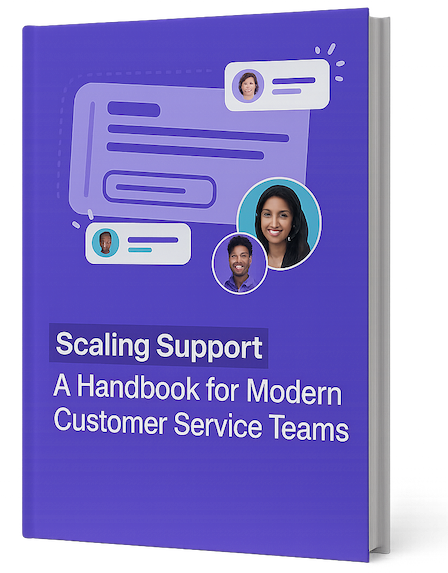Customer support operations is a critical component within your customer service.
These teams can massively improve your company’s operational efficiency and significantly enhance the customer experience.
Where would you be without your customers?
Though customer support operations often focus on the back-end functionalities, it really is the backbone of customer service departments. They ensure that every one of the customer interactions between a company and its customer base is smooth, efficient, and, most importantly, satisfactory.
In this article, we’ll go deeper into the intricacies of support operations, shed light on its definition, the essential role it plays within customer service, the key responsibilities of both customer support and operational support, and how these elements come together to meet and exceed customer demands and customer expectations.
By the end, you’ll understand how support operations impact customer satisfaction, customer loyalty, and overall company profitability.
What’s the definition of support operations?
Support operations is the tactical approach of enhancing internal staff capabilities, streamlining customer service workflows, and boosting the efficiency of the customer support team.
This strategic customer service function is instrumental in managing the infrastructure that enables frontline customer service representatives to deliver high-quality support.
Responsibilities of the customer support operations team are wide, including:
- Implementing customer service software and technologies for better customer engagement,
- Maintaining customer records for quick information retrieval, and
- Ensuring that the knowledge base is up-to-date and comprehensive.
If a customer support operations team is successful, they’ll have a direct and measurable impact on customer satisfaction, increase customer loyalty, and support the business’s profitability.
What are the necessary teams for good customer service?
These are the main components of a successful customer service department.
The Customer Support Team
The customer support team is the first line of interaction between a company and its customers, handling customer inquiries, resolving customer issues, and fostering positive experiences with the customer base.
This team manages the various communication channels—be it phone, email, chat, or social media—and develops workflow processes that aim for team efficiency and consistent support delivery.
A well-structured customer support team not only addresses customer needs effectively but also contributes to the overall customer satisfaction and customer loyalty by providing timely and empathetic responses to their concerns.
Faster response times and efficient resolution of problems directly impact customer retention and reduce customer churn.
Role of the customer support team
The customer support team is entrusted with the crucial task of maintaining customer satisfaction through direct engagement.
They not only respond to inquiries, but also:
- Proactively address potential issues.
- Guide customers through complex issues.
- Provide information about products or services.
- Provide feedback internally to improve product quality.
Skills required for customer support agents
To execute their roles effectively, customer support agents must possess a blend of technical know-how, customer service skills, and product or service knowledge.
They need to be proficient in:
- Excellent communication
- Empathy
- Problem-solving
- And be adaptable
These additional skills help them connect with customers on a personal level and devise workable solutions. Customer service representatives who’re great at these contribute significantly to maintaining a high quality standard and help the business as a whole deliver an amazing customer experience.
The Operations Team
The operations team plays a pivotal role in the behind-the-scenes orchestration of support efforts.
They focus on resource management, the hiring and training of support staff, and monitoring customer inquiries volumes to ensure that the customer-facing team is well-equipped to handle queries efficiently.
The team comprises various roles, including the support operations manager, developers, systems analysts, support trainers, and quality assurance testers, each contributing uniquely to the management and effectiveness of the customer support operations.
The responsibilities of a customer support operations manager go beyond oversight. They’re really responsible for improving customer service delivery, ensuring team development, and analyzing customer service metrics to identify areas for continuous improvement.
They’re especially critical in larger teams, where they can consistently advocate for the support team’s needs. Their job description includes both strategic planning and day-to-day responsibilities that keep operations running smoothly.
Collaboration between the customer support and operations teams
Seamless communication between the customer support and operations teams is essential for the delivery of exceptional service.
By working closely together, the two teams can identify bottlenecks in the support process, develop strategies to improve operational efficiency and effectiveness, and implement tools and technologies that enhance the overall customer experience.
Some of the toughest environments to work in are ones where the operations team and the support team are at odds–they should always be aligned on the same, impactful projects and outcomes.
Why are customer support processes important?
Efficient customer support processes are vital to enhancing the productivity of customer support teams and their overall effectiveness.
You’ll always have to review operational, strategic, and technical support processes, so they’re consistently aligned with customer needs and company goals. This means pulling data-driven insights via tools like Supportman or using automated workflows to streamline tasks, reduce response time, and personalize customer journeys.
Let’s look at some high-impact projects that a support operations team can implement, along with their measurable goals:
AI agent optimization
Goal: Increase first-contact resolution rates of AI chatbots from 45% to 65% within three months.
This project involves analyzing where the AI fails to resolve issues, identifying knowledge gaps, and improving prompt engineering. By increasing AI resolution capabilities, companies can:
- Reduce costs by handling more inquiries without human intervention.
- Decrease average handle time for customer queries.
- Improve customer satisfaction by providing immediate answers.
- Free up human agents to tackle more complex issues.
CSAT analysis and improvement
Goal: Identify the top three drivers of negative customer feedback and implement targeted improvements to raise overall CSAT scores from 78% to 85%.
This initiative leverages data-driven insights to:
- Map customer journeys to identify pain points.
- Correlate low satisfaction scores with specific interaction types.
- Develop targeted training for customer service representatives.
- Implement process changes based on concrete insights.
Knowledge base optimization
Goal: Reduce support ticket volume by 25% by improving knowledge base content and accessibility.
This project focuses on:
- Analyzing support tickets to identify common questions suitable for self-service.
- Restructuring knowledge base articles based on user search patterns.
- Implementing better searchability and suggested content.
- Measuring deflection rates and article effectiveness.
Quality assurance framework development
Goal: Establish a robust QA system that increases quality standards adherence from 76% to 92%.
This framework:
- Creates clear evaluation criteria aligned with customer expectations.
- Implements regular review cycles for continuous improvement.
- Ties agent performance to specific coaching plans.
- Uses Supportman to track improvements over time.
Keeping up with rapidly shifting expectations
The strongest support operations teams do more than build efficient systems. They create responsive frameworks that adapt to changing customer expectations.
This is where operational excellence translates into customer delight.
Customer expectations have skyrocketed.
Today’s customers aren’t just comparing you to your competitors. They’re comparing you to the best service experience they’ve ever had, period.
What do they want? Three things, primarily:
- Lightning-fast response times (minutes, not days).
- High-quality, personalized support (not generic templates).
- Proactive communication (solve problems before they notice them).
The difference between meeting these expectations and falling short directly impacts your bottom line.
Understanding customer needs
Here’s how top-performing companies stay ahead:
- They segment customers by behavior, not just demographics.
- Track product usage patterns across different customer base cohorts.
- Identify which features drive highest engagement among top-value customers.
- Map friction points that lead to support contacts and affect the customer journey.
- They connect feedback to specific touchpoints.
- If you identify that a significant proportion of negative CSAT scores stem from onboarding confusion, you can implement targeted improvements.
- And then analyze your CSAT rate to credit the outcome to that initiative.
- This represents a perfect example of the continuous improvement cycle in action.
- They measure sentiment across the entire journey.
- You can use journey mapping and sentiment analysis to see where customers run into the most issues.
- Proactive updates or optimized communication channels can lead to a direct impact on the customer experience.
- This approach to operations management is a way a support operations team can contribute to business success.
What this means for you: Every data point from your customer base is a strategic asset that can transform customer experiences. Are you capturing it effectively?
Adapting to changing customer demands
There are a few key ways to apply this in action:
- Capture feedback at critical interaction points using customer surveys and other tools.
- Route valuable insights to the right teams within hours, not weeks.
- Track resolution of identified issues to ensure service offerings meet expectations.
- Measure improvement over time to foster customer loyalty.
- Share customer insights in weekly cross-team standups with the entire team.
- Tie product roadmaps directly to top customer pain points.
- Give engineering teams direct access to customer conversation data to guide process optimization.
Want to accelerate your team’s feedback capabilities? Supportman is a powerful tool for collecting actionable insights and improving team performance. It makes it ridiculously easy to:
- Share real-time conversation ratings with your entire team via Slack.
- Track performance trends by agent, product area, and customer segment.
- Identify coaching opportunities instantly.
- Transform individual interactions into valuable insights for the whole organization.
- Support your continuous improvement cycle with data-driven decision making.
Building an effective customer operations team
Support operations combines efficiency, satisfaction, and profitability.
When your customer support and operations teams work together seamlessly, you create a service advantage that competitors struggle to match. By implementing the approaches outlined in this article, you’ll be positioned to:
- Deliver faster, more personalized service that meets rising customer expectations.
- Build scalable systems that adapt to changing needs and technologies.
- Increase customer loyalty and reduce churn.
- Drive measurable improvements in customer satisfaction scores.
As artificial intelligence and automation reshape customer service, your support operations must evolve too.
The companies that thrive will be those that balance technological efficiency with the human touch that customers still crave.
Supportman makes it easy to analyze 100% of your Intercom conversations, giving you the insights and learnings you need to improve your customer operations.


